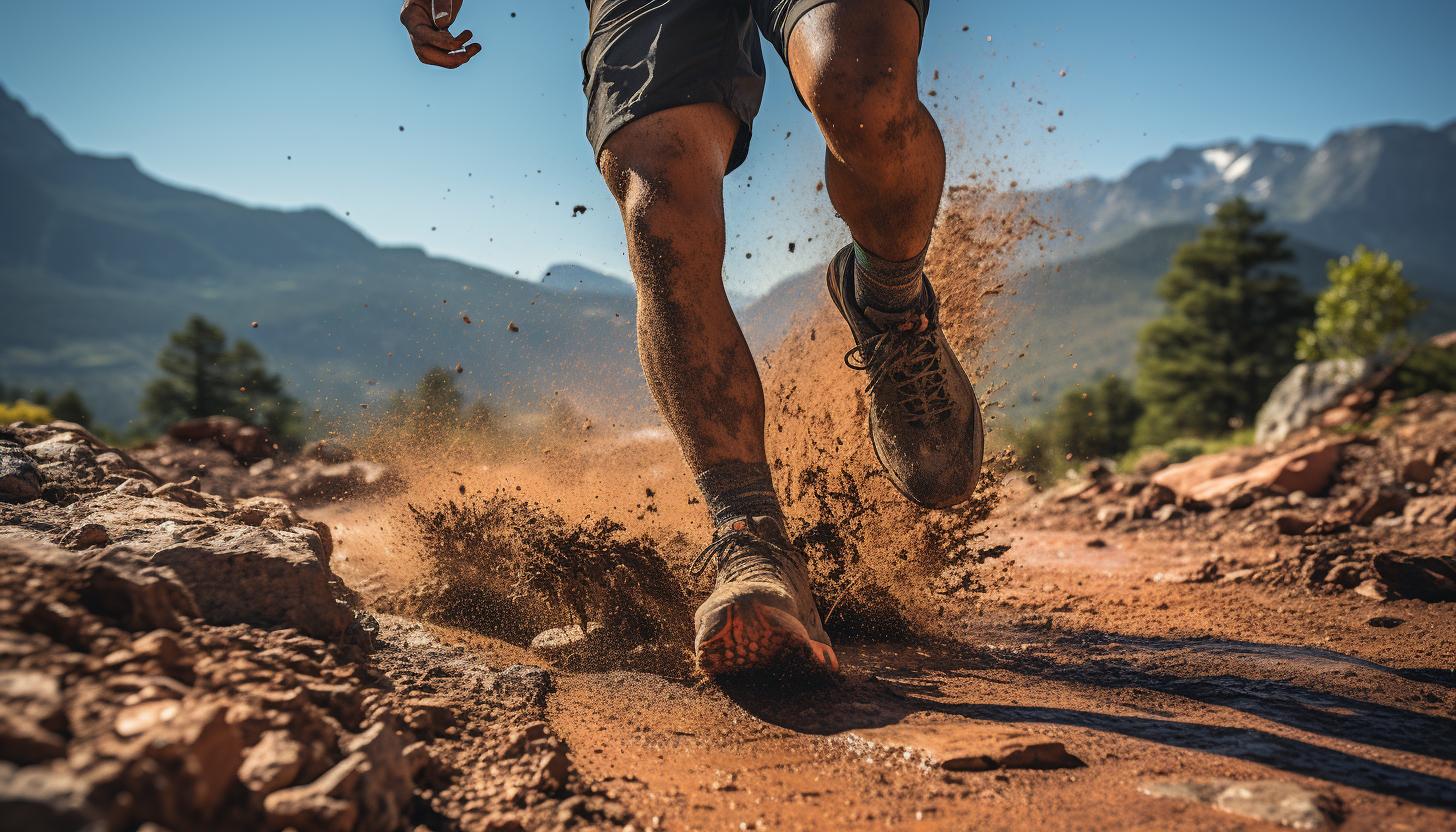Downhill Running: Strategies for Speed and Control

Are you ready to take your downhill running to the next level?
In this article, we will explore key techniques that will help you maximize your speed and maintain control on challenging terrain.
From mastering your footwork to perfecting your body positioning, we’ll cover it all.
Plus, we’ll delve into the importance of building lower body strength and share mental strategies for conquering any downhill challenge.
Get ready to improve your performance with these expert tips!
5 Key Techniques for Downhill Speed

One of the key techniques for downhill speed is leaning forward to maintain balance and control. Leaning forward allows you to shift your weight slightly ahead of your center of gravity, which helps prevent you from falling backward or losing control.
When running downhill, it’s important to adjust your body position to ensure stability and optimize your speed. To enhance your performance during downhill runs, proper equipment selection is crucial. Opt for trail running shoes that provide excellent traction and support. Look for models with lugs on the outsole to improve grip on uneven terrain. Additionally, consider wearing lightweight clothing that allows freedom of movement while also providing protection from the elements.
Breathing plays a vital role in maintaining energy levels and preventing fatigue during downhill running. Focus on deep belly breathing to maximize oxygen intake and fuel your muscles efficiently. Inhale deeply through your nose, expanding your diaphragm, and exhale fully through pursed lips. This technique promotes relaxation and ensures a steady supply of oxygen throughout the run.
Mastering Your Footwork for Control on Downhill Terrain

To maintain control on downhill terrain, it’s crucial to master your footwork. Your footwork techniques play a key role in maintaining balance and preventing falls when running downhill. By focusing on proper foot placement and quick adjustments, you can navigate steep slopes with confidence.
Here are some essential footwork techniques for maintaining control on downhill terrain:
| Technique | Description |
|---|---|
| Shortening stride | Reduce the length of your stride to maintain stability and prevent overextension. This allows for quicker adjustments as you navigate uneven surfaces. |
| Light landing | Land softly on your midfoot or forefoot rather than heel-striking. This reduces impact forces and improves balance while descending steep hills. |
| Quick turnover | Increase your cadence by taking shorter, quicker steps. This helps you react faster to changes in terrain and maintain momentum without losing control. |
Mastering these footwork techniques will enhance your ability to maintain balance and control during downhill running. Practice them regularly to improve your overall performance and reduce the risk of injury on challenging descents.
The Importance of Body Positioning for Efficient Descents

Maintaining the correct body positioning is essential for efficient descents, as it allows you to utilize gravity to your advantage and move smoothly down the slope. When it comes to downhill running, there are a few key techniques that can help improve your efficiency and endurance:
– Lean forward: Leaning slightly forward from your ankles helps you maintain control while descending steep slopes. It also allows you to take advantage of gravity and use it to propel yourself forward.
– Keep your arms relaxed: Your arms play an important role in maintaining balance during downhill running. Keep them relaxed and slightly bent at the elbows, allowing them to counterbalance any sudden movements or changes in direction.
– Shorten your stride: Taking shorter strides when running downhill helps reduce the impact on your joints and minimizes the risk of tripping or falling. It also allows for quicker foot turnover, which can increase speed and control.
Uphill running techniques for efficiency and endurance are equally important as they contribute to overall trail running performance. By utilizing proper body positioning during uphill sections, you can optimize energy expenditure while maintaining a steady pace. Additionally, navigating uneven terrain with confidence is crucial for a successful trail run. With the right body positioning, you’ll be able to adapt quickly to changes in footing and maintain stability throughout challenging trails.
Building Lower Body Strength for Descending With Power

Improve your efficiency and power while descending by building strength in your lower body. Building lower body strength is essential for downhill running as it allows you to generate more force and control your movements effectively.
One way to enhance your lower body strength is through plyometric exercises specifically designed for explosive downhill running.
Plyometric exercises involve quick and powerful movements that engage multiple muscle groups simultaneously. These exercises include box jumps, squat jumps, and lunge jumps. By incorporating these into your training routine, you can develop the explosive power needed to propel yourself forward while descending steep terrain.
In addition to plyometrics, another effective method for building lower body strength is by incorporating hill sprints into your training regime. Hill sprints not only target the muscles in your legs but also improve cardiovascular fitness. Find a challenging hill with a steep incline and sprint up it at maximum effort. Focus on driving your knees high and pumping your arms vigorously to maximize power output.
By regularly performing plyometric exercises and hill sprints, you will strengthen the muscles in your lower body, allowing you to descend with more power and control.
Remember to always warm up properly before engaging in any intense exercise routine and consult with a professional trainer if necessary.
Mental Strategies for Conquering Downhill Challenges

Stay focused and confident as you tackle challenging descents. Use mental strategies to overcome any obstacles in your path. Downhill running can be intimidating, but with the right mindset, you can conquer even the steepest slopes.
Here are some visualization techniques and tips to help you build confidence and overcome fear on steep descents:
– Picture success: Before tackling a downhill section, visualize yourself moving smoothly and effortlessly down the slope. Imagine every step being strong and controlled, allowing gravity to work in your favor.
– Break it down: Instead of focusing on the entire descent, break it into smaller sections. Set goals for each section and focus solely on reaching them. By dividing the descent into manageable parts, you’ll feel more in control.
– Positive self-talk: Use positive affirmations to boost your confidence. Repeat phrases like ‘I am strong,’ ‘I am capable,’ or ‘I can handle this.’ Remind yourself of past successes to reinforce your belief in your abilities.
By incorporating these mental strategies into your downhill running routine, you’ll find that fear diminishes while confidence soars.
Remember to stay present in the moment and trust in your training. With practice and perseverance, you’ll become a master of downhill running.
Conclusion
In conclusion, mastering the techniques of downhill running can greatly enhance your speed and control on challenging terrains. By focusing on footwork, body positioning, lower body strength, and mental strategies, you can become a more efficient and powerful downhill runner.
Did you know that incorporating downhill training into your regular running routine can improve your overall race performance? Studies have shown that athletes who regularly incorporate downhill running into their training have seen significant improvements in their race times.
So, don’t neglect this essential aspect of running and start implementing these strategies today to take your performance to new heights.






